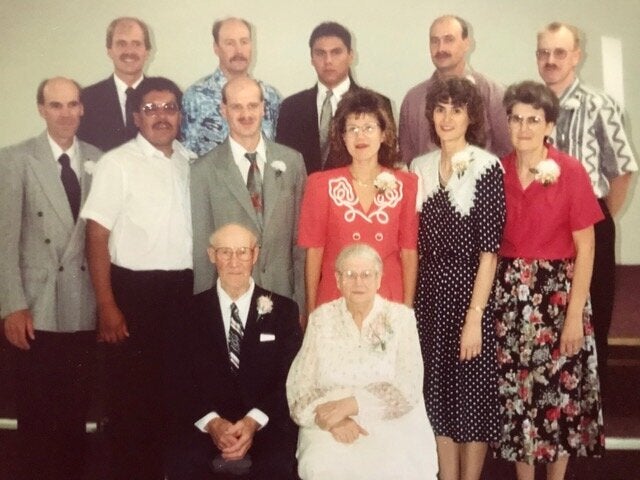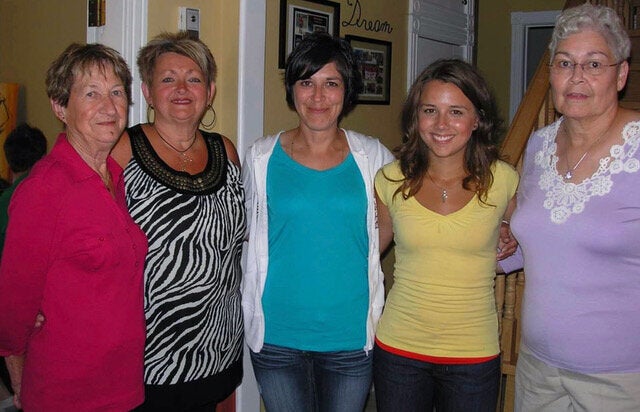We sat across from one another in a booth at a Smitty’s in Steinbach, Man., keeping cool from the heat of the July sun in the restaurant and trading stories from our childhoods. Patrons stole glances at my uncle, the only visibly Indigenous man there.
A generation apart — me in my 30s, him in his 50s — we were both adopted into a large, conservative Mennonite family, and faced a lifetime of struggling with our Indigenous identities amid a culture that asked us to set aside that part of ourselves.

Our exceptionally large extended family now has 40 Indigenous members, over 20 of us having been adopted or permanently fostered, making for quite the visual contrast with our white family members in group settings.
We mixed like oil and vinegar. There were moments of love, of course; together we would celebrate marriages and births, and mourn deaths. But for those of us with different backgrounds who had internalized our unbelonging, we were just thankful when these differences led to some laughter to interrupt our pain. We learned quickly that it was safer to hide our Indigenous selves, and that if we did not, it would be met with discomfort and fear, and often outright anger.
That’s why, all these years later, we’re still only just coming to terms with who we are.

I was adopted to my Mennonite parents in 1989 as an infant. What little familiarity I had with my hereditary Métis culture I gleaned from my experience with Manitoba Child and Family Services (CFS). After all, in Manitoba, we make up 90 per cent of the children in CFS.
My entire life, I have felt the product of both cultures, but the child of neither. I have no inherent connection with my family’s white culture; yet, aching to embrace my Indigenous roots has filled me with guilt, as if I’m somehow betraying the family that had raised me. It’s why it has taken me to this day to feel comfortable referring to myself as “Métis.”
I’ve heard “But you don’t look Métis!” more often than I can count, like I should feel relieved that my Indigeneity doesn’t show. My uncle, who was refused entry to Sunday school because of the colour of his skin, was surprised to hear that this is one of my greatest sources of shame.

He was adopted from a nearby reserve as an infant during the Sixties Scoop, joining 12 siblings. Around our town, my uncle is known by the common Mennonite surname “Dueck.” Tall, brown-skinned with thick, black hair, he surprises people with his fluency in Plautdietsch, the common language among Mennonites.
Elsewhere, my uncle is immediately recognized as a “Chief,” his biological surname. I’m told that when another of my adopted uncles was taken from his reserve at age four or five, and brought to my dad’s family, he would not let go of my uncle’s leg — the only other brown body in the house at the time. Their aunts and uncles openly disapproved of their brownness.
Living these two very different identities, my uncle described years of wreckage on his body and mind, with few opportunities to explore his identity or find healing. About a decade ago, I made the decision to seek closure myself.
Taking back my identity
Since first learning of my birth mother at the age of four, I spent my childhood imagining who she was. I wondered, would I look like her? Would my laugh echo hers? I couldn’t shake my desire to find out who this important stranger was and why she gave me up.
I met my biological mother shortly after my 20th birthday. After a few email exchanges, we agreed to meet at a restaurant. Walking in, I immediately recognized her dark hair and anxious demeanour from across the room. As we spoke, my hands were cupped nervously on my lap, both of us afraid to look the other directly in the eye. We giddily commented on how surreal it all felt.
My adoptive mom cried the first time she heard my biological mother speak words of endearment to me. Around the same time, my maternal grandmother had a nightmare that I abandoned her forever, never to be seen again. But reconnecting with my birth mother, and the rest of my family shortly thereafter, was a personal homecoming of sorts, filling in some gaps in my life.

My birth mother told me the length of her labour, the number of aunts and uncles and cousins I had, and that one aunt named her daughter after me — Megan, the name I was also given at birth.
I learned she became pregnant in high school at 17 and hid it with loose clothing until her third trimester. She delivered me before she graduated. My father wanted nothing to do with her pregnancy and had left the province by the time I was born. Others in her family had also given up children for adoption, so the process was familiar to her.
But she didn’t have all the answers I was looking for, like why my shame didn’t simply evaporate after reconnecting with my family, or why I still felt so alone.
Like so many others adopted during the era of closed adoptions and sealed documents, I had no access to my birth records until I was 20. That meant obtaining a tangible reflection of my identity, like a Métis card, was impossible. My one adopted aunt still isn’t even certain from which community she was adopted.
In some ways, we form a community of our own, marred with trauma but strong, with more ferocity and resilience than anyone ever seems to give us credit for. I know many others have waited 20 years or longer to find the time, courage and space to explore these pieces of themselves. That we’ve gone through a system that has rejected and erased our complicated identities, and are still here to speak of it, is an act of self-reclamation.
I have come to see my and my uncle’s taking back our identities as an act not only of survival, but of resistance.
My uncle and I walked out of the restaurant that afternoon, wandering eyes still sneaking side glances as he passed. I felt at once lighter in step and heavier in heart as I walked to my vehicle.
To know my uncle, to witness his survival, is to know a piece of myself. It is to know I am not alone, that others have gone before me — and even more alongside me — as we reclaim parts of ourselves and our culture.
As a child, I felt external pressure to withdraw from my Métis self, as an adult I felt internal pressure to disconnect from my Mennonite upbringing. My deepest desire is to live in simple acceptance of these two cultures and my two families, knowing that I am who I am, in part, because of them both.
Have a personal story you’d like to share on HuffPost Canada? You can find more information here on how to pitch and contact us.
Also on HuffPost: